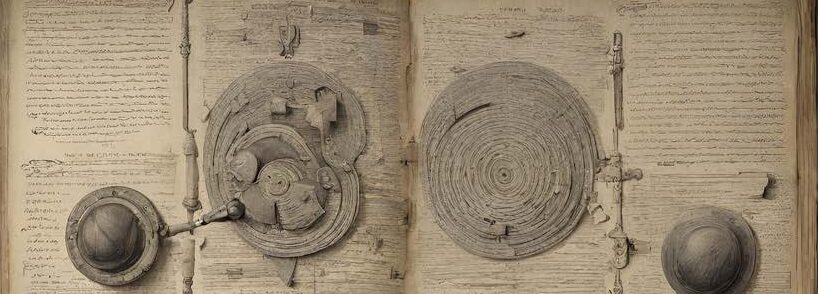Introduction
A typewriter is a machine with power that prints texts on paper. By enabling users to type characters onto paper using a keyboard, it was created at the beginning of the 19th century and revolutionized written communication. An improved and more readable alternative to handwritten writings was made possible and accessible by this ground-breaking invention (Gershon. L, para 1, 2017).

Vintage Typewriter
Derived from: Dreamstime
The history and development
Throughout the 19th century, writing machine experiments were conducted by inventors in both Europe and America. A large number of these gadgets were designed with hearing and vision impairments in mind. When it came to its works, the operators selected a letter by turning a dial in place of a keyboard, and then printed it on paper by pressing a lever or key. However, before the creation of computers, typewriters were an important component of business and personal communication. It helped create letters sent to loved ones, manuscripts, books, reports, and more (History of the typewriter, para 1, n.d).
Moreover, it had a big impact on literary works, as it gave economic power to single women since many of them were not married, divorced, and needed to find a way to live (Gershon. L, para 5, 2017).

A typewriters keypad
Derived from: Downeast
Functionality
When it came to its works, the operators selected a letter by turning a dial in place of a keyboard, and then printed it on paper by pressing a lever or key. Although they don’t resemble the typewriters we know today, they do demonstrate the developing interest in machines that could produce individual papers (History of the typewriter, para 2, n.d ). Although they were seen as a luxury good, its demand skyrocketed in the following years as businesses realized how valuable they were for modernizing and simplifying operations thanks to its fast-paced, and accurate functionality at that time.
Connections
In terms of its uses and connections throughout its history, typewriters were used by well-known writers, such as Ernest Hemingway and Mark Twain, to revise their works. Writing became easier to read thanks to the typewriter.
For example, during Ernest Hemingway’s life, typewriters were advanced and were oftenutilized by authors. Numerous typewriters, such as the multiple Royal portables, have been thoroughly worn out by Hemingway (Famous Authors, n.d) and “Life on the Mississippi” by Mark Twain was one of the first books to be typewritten (Marsdale, J. 2019).
However, a string of developments arose today.
The first devices that made mechanical writings possible were typewriters. When word processors first appeared in the middle of the 20th century, they combined electrical elements with features seen in typewriters. Word processing softwares moved to personal computers as technologies developed, which is how laptops and computers today can multi-task by having multiple open links, unlike a typewriter.

A typewriter as a three dimensional exploded diagram
Derived from: FlashBak
Its significance for writing practices
The features of the typewriter influenced writing techniques by highlighting accuracy, organization, and the significance of the final document’s look. I’ve worked with a typewriter twice in my lifetime, which is shocking because of how common it was to find it in people’s homes before. It resonates with me because of its formality, and its sequential style of writing, with pages advancing automatically, unlike Google docs, or Microsoft Word.
Another relation I find worthy is that it does not need wifi. With typewriters, the work done is infinite, the ink is easy to find and can be bought in bulk, and typewriters are used in the comfort of your own home, no wifi, no troubles.
It also has a calming sound to it. For me, its sound helps me focus, making me feel the knowledge I’m creating onpaper. Moreover, it arouses feelings of nostalgia, with each key press producing a distinct and gratifying “clack” or “thud” as the typebar hits the page. Nothing that will be created in the future could replicate a typewriter’s experience.
Its significance for reading practices
For its significance when it comes to reading in an era of technological advancement, the typewriter represents classic workmanship and writing skills. It makes me feel nostalgic and transports me to a time in the past when words were deliberately picked and penned. Every keystroke is a conscious act and a proof of the printed words power. With its physical presence, the typewriter serves as more than simply a tool, it serves as a constant reminder of the timeless value of literature and the elegance of simplicity.
References
Science and Technology. (n.d.). Explore. National Museums Scotland. https://www.nms.ac.uk/explore-our-collections/stories/science-and-technology/the-typewriter/typewriter-chapters/history-of-the-typewriter/
Famous Authors and Their Typewriters: Who Owns What? (n.d.). Catawiki. https://www.catawiki.com/en/stories/3979-famous-authors-and-their-typewriters- who-owns-what
Marsdale, J. (2019, April 22). Making a Comeback? 11 Facts on the History of Typewriters. Typewriters.com, a Division of Monroe Systems for Business. https://typewriters.com/blogs/making-a-comeback-11-shocking-facts-on-the-histo ry-of-typewriters
Gershon, L. (2018, February 28). How Typewriters Changed Everything | JSTOR Daily. JSTOR Daily. https://daily.jstor.org/how-typewriters-changed-everything/

Interesting, it’s amazing how far technology has gone. It makes me think of the early writers and more specifically typewriters as in profession who had to write everyday. Loved how you organized this, flows smoothly!